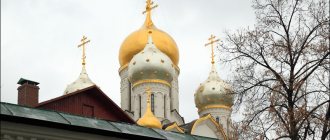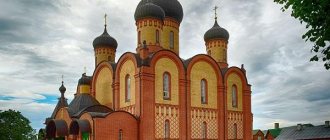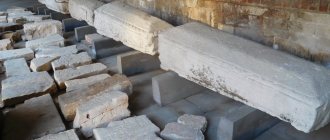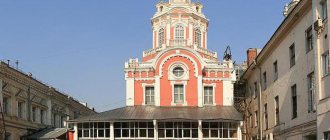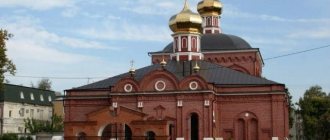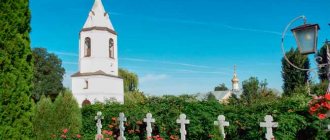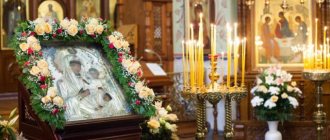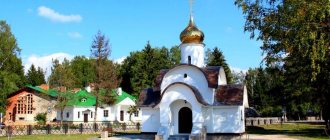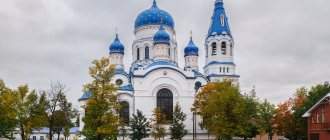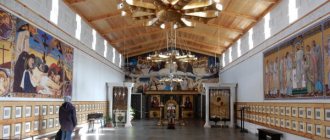Russian Orthodox Church
The first mention of the church in the village of Shostye is found in the salary book of the Kasimovsky district, where it is said that “the Church of St. Nicholas the Wonderworker was built in that village according to a blessed charter and consecrated in (1688).” Initially the church was wooden. In 1875, it burned down during a devastating fire that befell the village of Shostye. Many residents lost their homes and were in poverty, but the peasant community of the village expressed a desire to build a new temple in stone.
Ryazan provincial engineer N.N. Weiss drew up a project for a stone church with three chapels (the Ascension of the Lord, St. Nicholas and the Holy Martyrs Flora and Laurus) and a bell tower. Construction of the temple began in 1876 and lasted more than 25 years.
In the first decades after the 1917 revolution, the temple continued to operate, but was closed in 1937 and turned into a grain store, and later into a chemical fertilizer warehouse.
After the 1917 revolution, the temple remained operational for some time. In 1937 the church was closed. The temple was used as a grain store, and later as a warehouse for chemical fertilizers.
In 1999, the Church of St. Nicholas of Myra in the village. Shostye (Kasimovsky district, Ryazan region) was returned to the Church, by decree of His Holiness Patriarch Alexy II of June 22, a Patriarchal metochion was established at the temple. Priest Alexander Afanasyev (later Archimandrite Peter, abbot of the Zaikonospassky Stavropegic Monastery) was appointed rector.
The first service in the church after a many-year break took place on Easter 2000. After extensive restoration, St. Nicholas Church was given the status of a cultural heritage monument.
On May 30, 2002, the written blessing of His Holiness Patriarch Alexy II was received for the creation of a sisterhood at the Patriarchal Metochion of the Church of St. Nicholas in Shostya. The duties of the elder sister, with the blessing of the abbot, were entrusted to nun Antonia (Minina) (now Abbess Antonia, abbess of the Holy Trinity Alexander Nevsky Stauropegic Convent in the village of Akatovo, Klinsky district, Moscow region).
In 2003, a wooden church of the Assumption of the Blessed Virgin Mary was built on the territory of the Patriarchal Metochion. The consecration of the church took place on August 27, 2005.
In 2005, His Holiness Patriarch Alexy II entrusted the rector with the obedience to restore the former Holy Trinity Alexander Nevsky Monastery. Nun Antonia and several Shostien sisters moved permanently to the village. Akatovo. From that time on, the duties of the elder sister began to be performed by the nun Neonilla (Frolova).
In 2011, with the blessing of His Holiness Patriarch Kirill of Moscow and All Rus', the “Service for Assistance to Family and Children” was opened at the Patriarchal Compound.
The Holy Synod, at a meeting on December 24, 2015, decided to transform the Patriarchal Metochion into the St. Nicholas Shostiensky Stavropegic Convent, nun Neonilla (Frolova) was appointed abbess of the monastery (magazine No. 115).
On May 7, 2022, His Holiness Patriarch Kirill visited the Shostien monastery. The Primate performed the rite of great consecration of the St. Nicholas Church in connection with the completion of repair and restoration work (three altars were consecrated: the central one in honor of the Ascension of the Lord, the right one in honor of St. Nicholas, the left one in honor of the holy martyr Florus and Laurus) and headed the Divine liturgy in the newly consecrated church. At the small entrance, His Holiness elevated nun Neonilla to the rank of abbess and handed her the abbot's staff.
Nikolsky Shostiensky stauropegial convent Stavropegial monasteries of the Russian Orthodox Church
From the moment of the creation of the Patriarchal Metochion, the priority task was the restoration of the temple and the resumption of divine services; Extensive repair and restoration work was carried out over 17 years.
The first service after a long break took place on Easter 2000. In 2003, a wooden church was built on the territory of the Patriarchal Compound in honor of the Dormition of the Blessed Virgin Mary.
In 2011, the blessing of His Holiness Patriarch Kirill of Moscow and All Rus' was received to create a structural unit “Service for Assistance to Family and Children” at the Patriarchal Metochion. Currently, twenty pupils aged from seven to seventeen live there.
On December 24, 2015, at the next meeting of the Holy Synod, a decision was made to transform the Patriarchal Metochion of the Church of St. Nicholas of Myra in the village of Shostye into the St. Nicholas Shostye Stavropegic Convent.
On May 7, 2022, on the 4th Sunday after Easter, about the paralytic, His Holiness Patriarch Kirill of Moscow and All Rus' visited the monastery and performed the rite of great consecration of the St. Nicholas Church in connection with the completion of repair and restoration work, and led the service of the Divine Liturgy in the newly consecrated church.
Three Altars were consecrated: the central one in honor of the Ascension of the Lord, the right one in honor of St. Nicholas, the left one in honor of the Holy Martyrs Florus and Laurus.
At the small entrance, His Holiness Patriarch Kirill elevated nun Neonilla (Frolova) to the rank of abbess and handed her the abbot's staff. Nun Neonilla was appointed to the position of abbess of the St. Nicholas Shostien Monastery by decision of the Holy Synod of December 24, 2015 (magazine No. 115).
Now more than thirty nuns, led by the abbess, Abbess Neonilla (Frolova), permanently reside in the monastery. The sisters perform obedience in the church, bake prosphora, work in the icon-painting, gold-embroidery and sewing workshops, in the refectory, in the dairy shop, barnyard, in the garden and vegetable garden, bake bread, work with children and the population. The monastery operates a Sunday school, an Orthodox kindergarten, and a youth history lecture hall; three sisters serve as teachers at the Szostien Secondary School.
In the monastery, a full circle of daily worship is performed every day, the Inexhaustible Psalter is read, akathists to St. Nicholas and the revered icons of the Mother of God “Assumption” and “Iverskaya”.
Church of St. St. Nicholas the Wonderworker village of Shostye
The village of Shostye has been known since 1627. The first mention of the wooden church of St. Nicholas the Wonderworker is found in the salary book for 1683. It says that “based on the signature of the Kasimov elder priest Abraham and the letter from priest Prokhor, the St. Nicholas Church was built and consecrated in the village in 1688.” “Father Prokhor and the sexton” served in that church. In the parish of the church there was a summer house of Tsarevich Kasimov. The parish included 50 peasant and bobyl households. The temple was subject to a tribute of 1 ruble 12 altyns per year.
The old village church fell into disrepair over the years, and in 1785 it was decided to build a new wooden church with the same name. In 1828, the church was covered with planks, and a stone foundation was laid under it. Four years later, restoration work was carried out and the iconostasis was replaced. The temple was put in order and shone with splendor. But in 1876 there was a fire in the village, which did not spare the village church. The wooden building of the temple was completely burned down. In the same year, engineer N. Weiss developed a design for a new stone church building. After agreement with the diocesan authorities, a blessing was received from the Ryazan diocese to build a new church. And on August 5, 1876, a new church was founded in Shostya. Construction lasted two years, and in 1878 the new temple appeared in all its glory. There are three altars in the church. One in honor of St. Nicholas the Wonderworker, another - in memory of the martyrs Florus and Laurus, and the third in the name of the Ascension of the Lord. A bell tower was erected next to the temple, on which several small bells hung. 3 dessiatines of estate land, 24.5 dessiatines of arable land and 8.5 dessiatines of meadow land were allocated for the church.
The parish included the villages of Shostye and Anatolyevka, which had 412 households. There lived 1,273 men and 1,434 women, among whom 332 were literate.
According to the staff, the church consisted of one priest, one deacon and one psalm-reader.
Of the clergy who served in the rural church, the following are known:
Prokhor Semenov 1688-1708 Ivan Petrov 1708-1750 Georgy Dmitriev 1750-1790 Philip Georgiev 1790-1809 Alexander Ignatiev 1809-1820 Alexey Glebov 1820-1839 Yakov Fortinsky 1839-1856 Parmen Lebedev 1858
Today here is the courtyard of the Patriarch of Moscow and All Rus'. In 1999, a convent was founded in the village. And it all started like this. The rector of the Spassky Cathedral of the Zaikonospassky Monastery in Moscow, Father Peter, decided to open a courtyard for the purpose of raising orphans. First, they looked for an abandoned pioneer camp in the Moscow region in order to refurbish it and build a temple. But the paths led to the village of Shostye, where local residents wanted to open an abandoned temple and resume services.
Arriving at the place, Father Peter talked with the local administration and designed St. Nicholas Church as a patriarchal courtyard. The parishioners brought several icons, and on Easter in 1999, after a long break, the first service took place. It was so cold in the ruined church that the priest had to wear a padded jacket under his vestments. Thus began the revival of spiritual life in the village. Now the temple has been restored, the summer part is painted with frescoes, and not only sisters, but also children worked on them. Even preschoolers did simple work. At first it was planned that the monastery would be located around the temple, but, unfortunately, there was no place for this. First, four sisters arrived from Moscow. Now there are about sixty of them.
Nuns of the monastery The owners cultivate the land, keep poultry and livestock: sheep, goats, horses, and rare breeds of cows (they make amazing cheese from their milk). Children, schoolchildren and even toddlers, enjoy participating in the horse riding club.
The farm has modern equipment, which is used by hired workers from among the villagers. The project includes opening an almshouse for elderly Orthodox people.
In 2008, a boarding house for orphans and children in difficult life circumstances was opened at the monastery in Shostya. Angelica, a student at the orphanage and a graduate of last year, now Sister Ekaterina, wrote poetry, prose, songs, and won prizes for them in regional competitions. And this year’s graduate, Olga, an orphan, graduated from school with a gold medal. Ahead lies the implementation of big ideas and plans.
based on materials from the book by Ioann Dobrolyubov “Historical and statistical description of churches and monasteries of the Ryazan diocese”
Shostien miracle
0
On May 28, parishioners of the Ascension Church made a pilgrimage to the Nikolsky Shostiensky Stavropegic Convent. The monastery of the Shostien Monastery has existed for more than fifteen years. “It did not arise on the site of an ancient monastery, but grew up around an ancient parish church on the outskirts of the pious village of Shostye in the Ryazan outback,” says the abbess of the monastery, Abbess Neonilla. — At the request of the residents, the rector of the Zaikonospassky Monastery in Moscow, the future confessor and builder of the St. Nicholas Convent, Archimandrite Peter, came here in 1999. At his request, His Holiness Patriarch Alexei II of Moscow and All Rus' blessed the creation of a patriarchal courtyard in the village of Shostye. From that time on, the restoration of the dilapidated St. Nicholas Church under the godless regime began and the birth of a convent. During the years of persecution, St. Nicholas Church did not escape the fate of most Orthodox churches: in 1937 it was closed, turned into a collective farm warehouse, and a few decades later abandoned. From the day of the founding of the Patriarchal Metochion, one of the main tasks of the rector’s father was the revival of liturgical life in the St. Nicholas Church. The first Divine Liturgy was celebrated on Easter 2000. Through the prayers and labors of Archimandrite Peter (Afanasyev), sisters, benefactors and parishioners, St. Nicholas Church has now been almost completely restored. On December 24, 2015, the Patriarchal Metochion in the village of Shostye was transformed into the St. Nicholas Shostye Stavropegic Convent by the decision of the Holy Synod, chaired by His Holiness Patriarch Kirill of Moscow and All Rus'.” A boarding house was established at the monastery. It accommodates school-age girls whose parents decided to give them a monastic education and girls who find themselves in difficult life situations. Parishioners of the Ascension Church prayed at the Divine Liturgy in the St. Nicholas Church, and then went to the courtyard. Here they were divided into two groups: the first - children and adolescents, and the second - adults. The adults were told about the history of the village, the creation of the temple and the formation of the monastery, about the miraculous appearance of the statue of St. Nicholas the Wonderworker. They were also given a tour of the impressive territory of the farmstead, monastery gardens and gardens, and in the bread house they were told how delicious monastery bread is baked. The children visited the Assumption Church, got acquainted with its history and the stories of some of the icons, then they were shown a barnyard, where they were able to see many different animals, feed horses and pet real kids! This became an amazing entertainment for city children. In the St. Nicholas Church, on the choir in the chapel of St. Nicholas the Wonderworker, the children and their sisters sang the troparion of St. Nicholas the Wonderworker. And then the children went to the bell tower, where one of the sisters showed how the bells were rung. Then, the Ryazan pilgrims went to the source of Elijah the Prophet, where they were able to take holy water with them. Everyone really enjoyed the trip, everyone was delighted!
Brothers and sisters!
I would like to share the joy of the joint pilgrimage to the monasteries of the village that took place on October 21-23. Shostye, Ryazan region and Murom. There were three of us, our Olga driving her car, Tatyana and me.
In Shostya they weren’t allowed to take photographs, but I found pictures on the internet and added them to my album. Photos of Murom can be viewed at the link
https://photos.google.com/sha...
In the Nikolsky Shostiensky stauropegial convent there are 2 churches: one - Nikolsky, ancient, brick, stands separately, next to the pilgrimage hotel, refectory, and priest's house. Another, new wooden one in honor of St. Flora and Laurel are already called the female Mount Athos. It stands on the very territory of the monastery and men, except the priest, are not allowed into it for services.
The temples have unique icons. The former confessor of the monastery, Archimandrite Peter, the former abbot of the Zaikonospassky monastery, who recently died, handed over to Shostya the icon of the Iveron Mother of God of the Athos letter, an ancient prayer from the Kazan Church on Red Square, which was given to him, which was replaced by a larger copy.
Another icon, commissioned on Athos, was donated by spiritual children from Bulgaria and depicts the Mother of God, Abbess of Athos.
The miraculous icon of St. Nicholas the Pleasant was donated to the monastery by one of the nuns and decorated with an embroidered frame. The sisters themselves, with prayer and fasting, embroidered other icons of extraordinary beauty for about two years.
The monastery has a shelter for girls and a well-equipped school. In the farm yard there are poultry, goats, sheep, cows, 8 horses. The farmstead provides Adyghe cheese, cottage cheese, and milk. There is a bread house (they bake it themselves).
Here, workers are needed at any time and preferably for a long period of time (from a week or more). The guest house is well-equipped, there is 1 shower cabin, hot water. The food is tasty and varied. You can arrange a trip there through me.
The problem is that the monastery does not have its own website, so information about them is passed on by word of mouth and, of course, the spiritual children of Archimandrite Peter do not leave the monastery with their attention.
On Sunday, early in the morning, we went to Murom, managed to attend part of the liturgy and the prayer service of St. Blessed. Peter and Fevronia. We were honored to venerate the relics when the shrine was opened.
We met with Lyubov, our Azbukovka resident of Murom. Together with her, we walked through other monasteries of the city, and venerated the local shrines with love and reverence. We are honored to ring the belfry! Oh, we made a lot of noise, driving away the demons with the ringing of bells!
God's gift for us was a visit to the 4th monastery of Murom, the Holy Resurrection Women's Monastery, which was first mentioned in 1566 in the Scribe Book and in which, according to legend, Fevronia settled after accepting the monastic rank... it was there that she completed the church cover and asked her husband to wait until she finished sewing so that she could sleep at the same time as him.
The stone five-domed Resurrection Cathedral was built after 1637 and has survived to this day without significant changes. And although, on the orders of Catherine, the Second Monastery was abolished, the Resurrection and Vvedenskaya churches became parish churches.
Monastic life resumed only in 1998. The Vvedensky Church was restored, and restoration work was still underway in the Resurrection Cathedral.
Imagine our joy and surprise when it turned out to be open, and we were honored to see it from the inside and venerate the B.M. “Feodorovskaya” icon with a centuries-old history, the revered image of the Most Holy Theotokos “Joy of All Who Sorrow,” the icon with part of the stole of John of Kronstadt and other shrines.
Labor is also required here. Tel.8(49234) 3−04−35, e-mail
Thank God for everything!
God bless, R.B. Love for your hospitality and the story about your city and monasteries! Dear One, give her earthly love and God’s grace!
God bless R.B. Olga - without her this trip would not have taken place in such volume and quality.
God save R.B. Tatiana, who somehow unnoticed from the “backup” became the main one).
Save, Lord, me, the sinner R.B.Mary, unworthy of Your Mercy!
